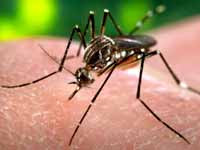KUALA LUMPUR: Two new deaths were registered yesterday due to Influenza A(H1N1), bringing the number of deaths till now to 76.
Health Director-General Tan Sri Dr Mohd Ismail Merican said the victims were a 45-year-old woman from Sabah who had high fever and a 19-year-old girl from Bentong, Pahang.
Meanwhile, 156 new patients with influenza-like illness (ILI) were admitted to hospital today for treatment while 189 cases were discharged.
"This makes the remaining ILI cases number 881 being treated in 98 hospitals including 11 private hospitals. Of this number, only 141 patients (19 per cent) were confirmed positive for H1N1," he said.
Dr Mohd Ismail said of the 141 H1N1 cases, 37 cases were in the ICU where four were new admittances and four cases had left the ICU.
"Of the 37 cases in ICU, 28 (76 per cent) had high risk factors that is chronic illness (nine), respiratory illness (three), obesity (six), children below the age of five (eight) and pregnancy (two)," he said.
Dr Mohd Ismail said while Muslims were busy make preparations for Hari Raya, the ministry wanted to advise people to practice self-hygiene, not to be indifferent and to seek immediate treatment if they have Influenza A (H1N1).
"People are encouraged to have with them the H1N1 kit (nose and mouth mask, tissues and sanitizer) wherever they go while shopping, on public transportation or celebrating at homes of relatives and friends and also to keep up-to-date on latest developments about the Influenza A (H1N1) pandemic and steps suggested by the ministry from time to time," he said.
Tens of millions of people could be infected with swine flu in China
BEIJING — Tens of millions of people could be infected with swine flu in China in the coming months, a health ministry official said Friday, adding that fatalities would be "unavoidable".
The world's most populous nation, at 1.3 billion, has so far reported nearly 7,000 cases of A(H1N1) influenza but no deaths. It soon plans to launch a nationwide vaccination programme to prevent mass outbreaks of the virus.
"According to expert estimates, our nation during the autumn season might have several tens of millions infected with A(H1N1)," Liang Wannian, deputy director of the ministry's health emergency office, told a press conference.
Liang said of that total, "half of them could experience clinical symptoms, several millions will seek medical help, and serious cases and fatalities will be unavoidable."
The spread of A(H1N1) influenza in China has gathered pace as the autumn months approach, Liang said, with more than half of the nation's nearly 7,000 cases detected between August 24 and September 10.
Of those cases, nearly 95 percent were homegrown, whereas the vast majority of cases reported from June to August originated abroad, he said.
"The situation we face is not optimistic," Liang said, noting that the virus had been found in all of China's 31 provinces and regions.
"We are facing severe challenges in our prevention and control work."
The World Health Organization (WHO) said last week that more than 2,800 people had so far died around the globe from swine flu. The virus has been detected in nearly every country.
"What we must work to prevent is a peak explosion of infections in a short period of time -- if this happens, it will be very dangerous," Liang said.
"If we see a large number of people infected in a short period of time, then a lot of people are going to seek medical help and our health system will not be able to handle this."
The State Council, or cabinet, on Thursday issued new regulations on handling A(H1N1) outbreaks, ordering the ministries of health and education, and the food and drug administration to coordinate prevention and control.
Such efforts will focus on schools as China has witnessed more than 200 "large-scale" outbreaks of swine flu since June, with over 85 percent of them occurring in schools or at school-related activities, Liang said.
CHINA A(H1N1)flu - 10,000 confirmed cases now!
SHANGHAI — China looked set for a tough winter as confirmed cases of H1N1 flu reached 10,000 across the country this week and they appeared to by multiplying fast.
"In the last week or so, the increase has been quite quick," Vivian Tan, communications director for the World Health Organization in Beijing, said in an interview.
China was the first country in the world to develop an H1N1 vaccine, and although it was rushed into production earlier this month it is expected to produce enough serum to vaccinate only about five per cent of the country's 1.3 billion citizens. "Quite frankly the production capacity is not enough," Tan said.
Throughout the summer, H1N1 appeared to be confined to China's big cities, but health officials now say it is moving into rural areas and all 31 provinces and regions have reported cases.
China has so far recorded no H1N1 fatalities.
A(H1N1)is like avian flu on steroids.
WASHINGTON (Reuters) - Autopsies on people who have died from the new pandemic H1N1 flu show this virus is different from seasonal influenza, even if it has not yet caused more deaths, experts told a meeting on Tuesday.
Americans who died from swine flu had infections deep in their lungs, Dr. Sherif Zaki of the U.S. Centers for Disease Control and Prevention told a meeting of flu experts, including damage to the alveoli -- the structures in the lung that deliver oxygen to the blood.
This in turn caused what is known as acute respiratory distress syndrome -- an often fatal development that leaves patients gasping for breath.
The World Health Organization has confirmed 3,205 deaths globally from swine flu but experts agree all estimates of the extent of the pandemic are grossly understated because so few patients are ever actually tested.
Seasonal flu kills, too -- about 250,000 to 500,000 cases a year globally, according to the WHO. But not in the same way as swine flu, which unlike seasonal flu frequently causes severe disease in young adults and children.
"It is very rarely you see what we call diffuse alveolar damage in fatal seasonal influenza," Zaki told a meeting sponsored by the U.S. Institute of Medicine, which advises government on health matters.
Seasonal flu causes bronchitis and other upper respiratory disease. But Zaki, the chief infectious disease pathologist at CDC, said the new virus had burrowed into the lungs of the 90 or so people he examined after they died, and they had huge amounts of the virus in their blood.
"This is almost exactly what we see with avian flu," Zaki said. "This looks like avian flu on steroids."
Earth becoming a disease hot spot : The warming earth is making us sick. Rising temperatures, frequent floods and prolonged droughts are ideal conditions for infectious diseases to spread. "Global warming is fuelling epidemics in areas which are unprepared. We're seeing the emergence of new diseases around the world. Old diseases are also coming back with a vengeance," Climate change has dramatically changing infection trends.
DENGUE DEATH CASES INCREASES BY 65% IN 2010
SAVE THE WORLD - STOP GLOBAL WARMING

Either You're With Me or You're Against Me in Stopping Global Warming!
Global Warming Articles
Let's Go Green & Save The World : Mentor Gemilang
The Truth Hurts - Truth is such a rare thing, it is delighted to tell it.

You can fool some of the people all of the time, and all of the people some of the time, but you can not fool all of the people all of the time.
Most truths are so naked that people feel sorry for them and cover them up, at least a little bit.
Truth always rests with the minority, and the minority is always stronger than the majority, because the minority is generally formed by those who really have an opinion, while the strength of a majority is illusory, formed by the gangs who have no opinion
Let's Go Green - Mentor Gemilang 1 - Visitors from 90 Countries
LATEST NEWS
Are u protected against Influenza A(H1N1)?
Repentance (At Taubah)
We can never be perfect since even prophets have at times made mistakes. Repentance means to abandon one's rebelliousness and arrogance before God and to stop deliberately disregarding His commandments without feeling any shame. Repentance also means to humbly hope for the mercy of God and to fear His judgment while doing the best one can to fulfill divine wishes within the limits of one's human weaknesses.


